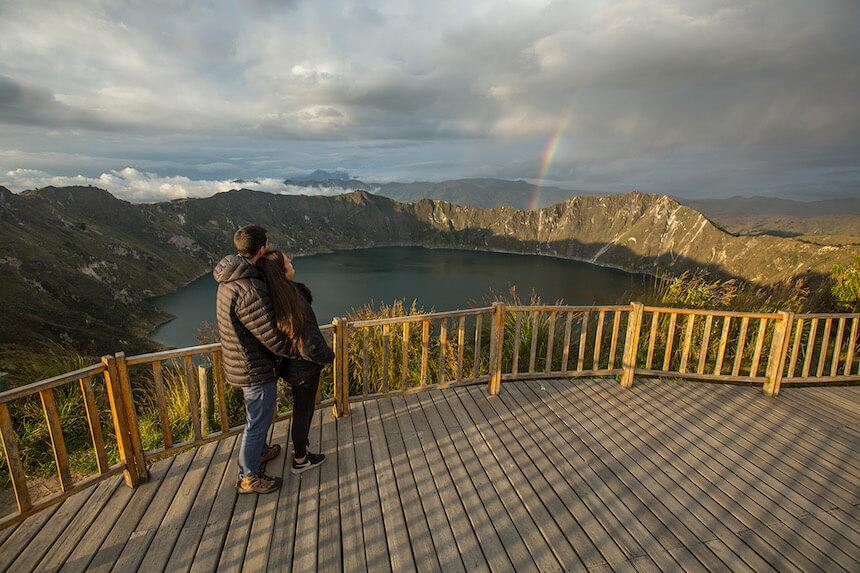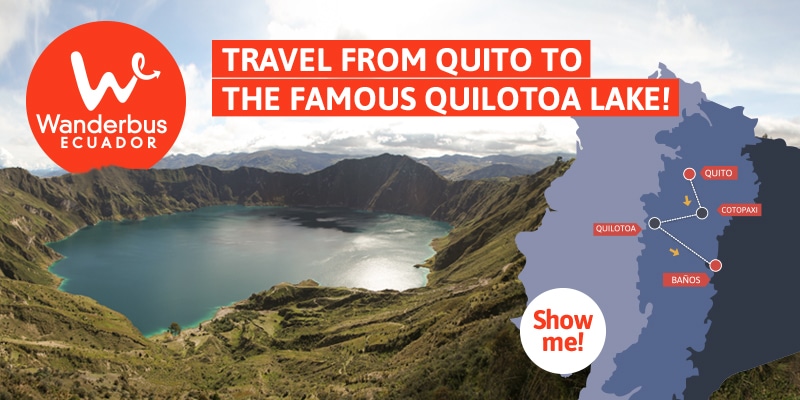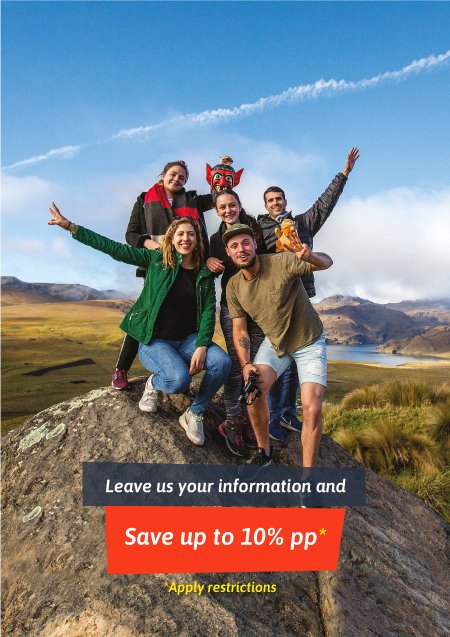Lonely Planet notes that ‘the famous volcanic-crater lake of Laguna Quilotoa is a gasp-inducing sight’ and we have to agree. This is one of the most stunning vistas you will come across in Ecuador, and while technically a caldera, this crater was formed nearly a thousand years ago following the collapse of a volcano. The water of Quilotoa lake is a brilliant turquoise color due to the dissolved mineral deposits and, on a clear day, you can see an expanse of the Andes Mountain Range in the background. It is truly a sight to behold!
How to Get from Quito to Quilotoa?
Quilotoa is a super destination for those among you that want to experience the Andes on foot or horseback, climbing the steep wall of the crater, around its rim and through the small towns found in the neighboring high-altitude countryside.
Only around 4 hours from Quito to Quilotoa, this is an excellent destination when you only have a few days to discover the capital and surrounding areas. If there’s anything you can’t miss during your trip to the Ecuadorian Andes, it’s a visit to the otherworldly Quilotoa crater.

Note: The last ATM you’ll come across will be in Latacunga, and many of the hostels in the Quilotoa area don’t accept credit or debit cards. Make sure to take out enough cash for your trip and keep it in a secure place.
To get from Quito to Quilotoa, you’ll likely need to pass through Latacunga first, though your route and mode of transport may vary depending on your trip plans. More below:
Public transport: To get from Quito to Quilotoa by public transport, you’ll need to first go to the Quitumbe bus terminal, located in the south of Quito.
To get to the terminal, you can either take a taxi (depending on the time of day, this can cost between $10-20 dollars) or the trolley line headed South. If you decide on the trolley, make sure you travel by day and always keep an eye on your belongings.
- Quito to Quilotoa (direct): Only one bus company in Quitumbe, “La Illinizas”, offers direct service from Quito to Quilotoa, leaving at 5:00 p.m. every day for about $3. The trip takes around 3 hours.
- Quito to Latacunga: Buses leave from the Quitumbe station in Quito to Latacunga every 10 minutes and cost $2.50. The trip from Quito to Latacunga only takes about 1 hour.
- Latacunga to Quilotoa Crater: Once in Latacunga, you can grab a bus straight to the crater, which takes about 2 hours for $2. The buses only leave a few times a day, starting at 9:30am. If you’re only planning on visiting Quilotoa for the day, make sure to ask the bus driver when the last bus leaves from Quilotoa, likely around 3pm.
- Latacunga to Chugchilán: If you’re planning on spending the night in the area, you can take a bus to Chugchilán, a small town about 40 minutes drive from the Quilotoa crater. Chugchilán is a great jumping off point for those that want to hike the Quilotoa Loop and have more time to explore the surroundings.

Wanderbus Ecuador: Alternatively, you can get from Quito to Quilotoa on the Wanderbus, which leaves regularly from Quito at pre-selected, convenient pick-up points. Wanderbus is an excellent option for those that don’t wish to deal with the headache of figuring out public transport and facing potential safety risks.
For instance, the Jacamar Pass goes from Quito to Baños three times a week, stopping by Cotopaxi and Quilotoa crater on the way. If you wish to stay in the Quilotoa area for a few nights, simply hop off the Wanderbus and hop back on when it passes through a couple of days later.
A note about safety while traveling in Ecuador
Ecuador is a backpacker’s paradise because of how easy and affordable it is to get around. Public transportation can get you from the beach to the Andes for only a few dollars! That said, you should take extra precautions when planning your trip using public transport. As in many South American countries, theft and assault are a risk, particularly for solo travellers and women.
Here are a few tips to help keep you safe while travelling through Ecuador:
- In Latacunga, specifically, keep a close eye on your personal items and preferably don’t use the ATM.
- Avoid travelling by night. Though many public buses leave or arrive late at night/early in the morning, these are also the hours when robberies and assaults are more likely to happen.
- Safety in numbers: Travel with friends, or stick with new friends you make on the road.
- Don’t carry around too much cash. Instead, use a credit/debit card or travellers checks and only take cash out in safe areas (e.g. at a bank or your hotel).
- Avoid dangerous neighborhoods. When you first arrive to a new city, make sure you identify which neighborhoods are best to avoid. Your hostal can give you specific information about this.
- Don’t tempt thieves!: Hide expensive objects such as your camera, phone and jewelry and always keep your backpack on you, preferably in a way that makes it difficult for someone to unzip its compartments.
- When traveling by bus, either store your bags under the bus, or keep them with you, but don’t store them under the seat or in the overhead rack.
- If you’re going to take taxis, take safe taxis. Ask your hostal to call you a taxi or use applications like Uber or Cabify.
- Consider services like the Wanderbus, which is safer and more convenient than public transport, gets you to all the best destinations, and provides the additional fun and safety of a group setting with the flexibility to also do your own thing.
Activities to do in Quilotoa
Depending on whether you are just visiting Quilotoa for the day, or planning to spend a few nights in the area, your preferred activities may vary.
Day trip to Quilotoa
If you arrive in Quilotoa just for the day, you’ll probably only have enough time to explore the crater and grab a bite to eat at the hotels and restaurants by the crater entrance.
Hike around Quilotoa crater
This hike takes you around the rim of the crater, providing incredible views of the crater itself and the surrounding landscape. This is a relatively easy hike, though there are a few narrow spots, and takes about 6-8 hours to complete, depending on your level of fitness and pace.

Hike into the crater
This downhill trek will take you right up the the turquoise waters of Quilotoa lake, where you can rent a canoe for an hour or more and explore this eerie, beautiful place. The hike back up the crater is quite challenging at over 4,000 meters in altitude (13,000 feet). If you don’t think you’ll manage, you can always get a ride up the crater on a donkey.
Multi-day trip to Quilotoa
Given the beauty of the natural surroundings here, you may decide to spend a couple more days in the area. This lends itself perfectly to the following activities, apart from the ones listed above:
Quilotoa Loop
The Quilotoa Loop is a longer, three day hike that starts in Quilotoa and takes you to the village of Sigchos. On the first day, you can hike to the nearest village of Chugchilan, which will take about 5-6 hours. Here, you can stay at one of the hostels available. On the second day, you’ll hike to the village of Isinlivi and finally on the third, and last day, you’ll arrive in Sigchos, a larger village with some shops where you can catch the bus back to Latacunga. If you have time, stop on the way at Saquisili market (held on Thursdays).
Horseback ride from Chugchilan to Quilotoa Crater
A popular activity is to ride a horse from the village of Chugchilán, where you might be staying the night, to Quilotoa crater. The trip takes 3 hours and costs around $20. The horses can be rented in Chugchilán, just ask your hostel for more info.
Packing list for Quilotoa: What to take on your trip to Quilotoa
Traveling from Quito to Quilotoa, prepare for colder, higher altitude weather. While Quito sits at around 2,800 m.s.l (over 9,000 feet), Quilotoa sits at nearly 4,000 m.s.l (13,000 feet). If you’re planning to go on a few longer hikes in the area, apart from your regular packing items, make sure to pack layers and wind/waterproof clothing. Windchill can be a factor in this area, so if you tend to get cold, take gloves and a hat along, just in case.
If horseback riding or hiking are in the plans, bring a pair of versatile and comfortable shoes. And since Quilotoa is at a higher altitude, be weary of the sun! Take a hat, sunglasses and apply plenty of sunscreen to avoid getting sunburnt.
While the town around the crater and in Chugchilán offer a few stores and restaurants, food and water may be otherwise difficult to come by while exploring this area. Make you bring snacks and plenty of water on your hikes.
Here’s a consolidated list for easier viewing:
- Food/snacks and water
- Comfortable, versatile shoes
- Windbreaker and rainproof jacket
- Layers for the cold (fleece, under armor, gloves, hat)
- Sun protection (hat, sunglasses, sunblock)


